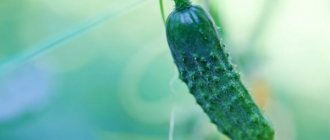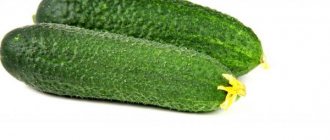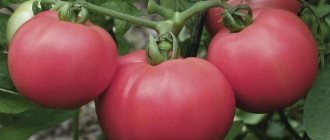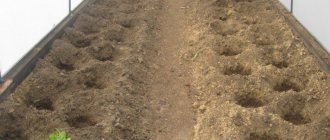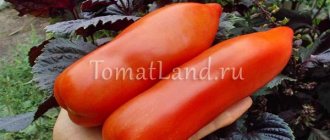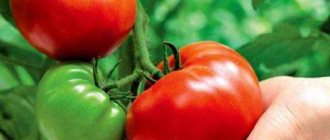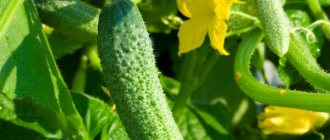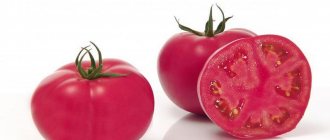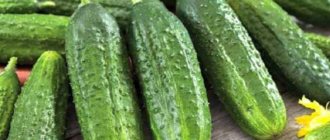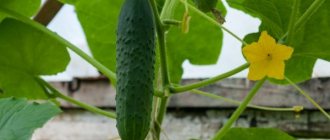Pasadena f1 is a highly productive Dutch hybrid, which is included in the State Register. It is actively cultivated in the Middle Volga and Central regions in large and small farms, suitable for open areas and protected soil. The hybrid is cultivated by trellis and spread.
| Landing location | Ripening time | Mode of application | Fruit length | Group | Fruit smoothness | Pollination method |
| Universal | Mid-early (46-55 days) | Universal | Short (gherkins) - less than 10 cm | Hybrid | Highly lumpy | Parthenocarpic |
Characteristics of the variety
The hybrid cucumber “Pasadena f1” is intended for fresh consumption, as well as for pickling and canning. Parthenocarpic cucumber has a high degree of resistance to cladosporiosis, and also has relative immunity to powdery mildew and cucumber mosaic virus.
The bushes are fast-growing, well-leafed, with a predominantly female type of flowering. The average length of a ripe fruit can vary from 6 cm to 9 cm. The fruits are cylindrical in shape, with a pronounced tuberculate surface. The average weight of the fruit is 65-95 g. The pulp has no bitterness and voids. Taste and product indicators are very high. The total yield, depending on the type of soil and quality of care, is about 11-14 kg per square meter.
A variety that pleases with high yield and excellent taste - Pasadena cucumber f1: full description
Pasadena f1 is a highly productive Dutch hybrid, which is included in the State Register. It is actively cultivated in the Middle Volga and Central regions in large and small farms, suitable for open areas and protected soil. The hybrid is cultivated by trellis and spread.
| Landing location | Ripening time | Mode of application | Fruit length | Group | Fruit smoothness | Pollination method |
| Universal | Mid-early (46-55 days) | Universal | Short (gherkins) – less than 10 cm | Hybrid | Highly lumpy | Parthenocarpic |
Description and characteristics of the variety
Pasadena f1 ripens in 48-50 days from germination and belongs to the line of mid-early varieties. Characteristics of the bushes: reach 2-2.5 m, bloom predominantly according to the female type. Up to 3 gherkins are tied in 1 knot.
What are the signs and description of the fruit:
- gherkin type;
- length 6-9 cm;
- weight 65-95 g;
- elongated cylindrical shape;
- tubercles pronounced, frequent;
- elastic consistency;
- the pulp is crisp, without voids;
- The taste is classic without bitterness or acid.
Gherkins are used in the preparation of a variety of fresh, salted and pickled dishes.
Advantages and disadvantages
- strong immunity to cladosporiosis, VOM, MR;
- good germination;
- stress resistance;
- productivity;
- resistance to unpleasant weather factors;
- pleasant taste and attractive appearance;
- the fruits never taste bitter;
- prolonged fruiting period;
- marketability and transportability.
Minuses:
Productivity
Pasadena f1 gives a harvest of 11-14 kg per 1 m2 per season if simple rules are followed.
Landing
Cucumber seeds are sown in uncovered beds after the frosts have stopped, when the ground has warmed up to 14 degrees at a depth of 3-4 cm.
Using the seedling method, the harvest is harvested a couple of weeks earlier. Planting of seeds begins in mid-April. The composition of the soil mixture includes:
- 2 parts leaf turf;
- 2 parts compost;
- 1 part sand and peat.
Seedlings can be transferred to a permanent place with 3-4 leaves. A week before this, the bushes are fed with nitroammophoska. Compost is added to the beds in advance, 2 buckets per 1 m2 and 25-30 g of phosphorus-potassium fertilizer. In case of increased acidity of the soil, the following is added to neutralize:
Sandy loam and loose light loams are suitable for cucumbers; it is undesirable to plant bushes in places where groundwater is close to the groundwater.
Growing and care
Standard cultivation technique:
- fertilizing 4 times per season;
- installation of supports and garter;
- watering 3-6 times a week (taking into account humidity);
- loosening or mulching;
- preventive work to protect against pests;
- shaping and pinching side stems.
During the fruiting stage, water more often than before. Use settled water with a temperature within 20-25 degrees (cold water promotes the appearance of root rot). The liquid rate varies depending on weather conditions within 8-14 liters per 1 m2. The procedure is carried out in the evening hours. Using the drip method is effective.
The bushes are led into 1 trunk, at the top of the trellis structure the main shoot is pinched or broken. Yellowed and aged leaves are regularly cut off as part of maintenance.
Fertilizers are applied regularly - every 2 weeks, alternating organic matter with minerals. The following are used as fertilizers:
- complexes Agricola, Dobrivo, Clean List;
- minerals – superphosphate and potassium salts;
- solutions of organic matter from mullein and manure, dilution 1 to 12.
The crop is harvested regularly, which improves fruit set and productivity.
Landing rules
Cucumber variety "Pasadena f1" is suitable for growing in open and closed ground. Seeds should be sown after the threat of frost and after the soil has warmed to a depth of 10 cm to 10-12°C. The standard sowing scheme for prepared seed material is 3-5 plants per square meter.
One of the primary sources of fungal, bacterial and viral diseases of cucumber in home gardens is the use of infected seeds for planting. Description of the variety, rules for pre-sowing preparation of seed material, as well as features of direct sowing and seedling cultivation from the originator Syngenta are as follows:
- seeds of this variety are sold after treatment with the fungicide “Tiram”, therefore, when planting, the seed should not be soaked or subjected to additional treatment;
- planting cucumber seedlings is an excellent way to significantly speed up the emergence of vegetable seedlings, as well as the harvest;
- cucumber seeds are sown when the temperature of the soil at a depth of 10-12 cm is approximately 12-14 ° C, and also when the risk of return frosts has passed at the time of germination;
- when planting on ridges of open ground, it is recommended to add 500 grams of manure or humus, supplemented with wood ash, to each planting hole;
- seeds are sown to a depth of 1-2 cm according to the standard planting pattern of 30x60 cm.
When planting, the soil must retain its natural moisture, otherwise the soil is spilled with water in each planting hole at the rate of 1 liter per plant.
Growing technology
Cucumbers of the Pasadena f1 variety are responsive to proper care measures at all stages of the growing season:
- at the initial stage of the growing season, watering is carried out once every 2-3 days, and approximately 7 liters of warm water are required for each square meter;
- at the budding stage, watering should be reduced, and the previous frequency of irrigation measures will be required for cucumbers only during the phase of mass formation of greens;
- in the first two weeks, cucumbers need increased nutrition with nitrogen-containing fertilizers, and at the flowering stage, nitrogen fertilizers should be replaced with phosphorus;
- in case of insufficient flowering, it is advisable to feed the cucumbers with potassium-phosphorus fertilizers, and high efficiency was noted when applying additional fertilizing based on urea and humus;
- temperature conditions are very important for cucumbers, so during the fruiting phase the temperature should be 18-24°C.
Cucumbers have proven themselves very well when grown on vertical trellises. In addition, it is important to use the pinching method. The formation of cucumber bushes should begin after 6-8 leaves appear on the plant.
Garden
Cucumbers in a greenhouse.
On the left in the bowl are the small lumpy ones - this is Pasadena.
This year I reduced the number of cucumber varieties in the greenhouse, and I also reduced the number of cucumber vines, albeit slightly. I decided to plant tomatoes in the same greenhouse. Therefore, in cucumbers I focused on a proven variety - Pasadena
. It was not possible to buy other varieties from this series this year. You try new varieties, test, choose, and then you can’t find seeds - it’s a shame. This happened this year (as well as in the two previous years) with the entire musical series of Dutch varieties. Of the entire series (Pasadena, Pasamonte, Pasalimo) I found only Pasadena, but I’m terribly glad about that.
| Pasadena did not disappoint this time either. The earliest, most friendly, begins to bear fruit from the very bottom. There are also real leaves from the heels, and the ovaries are already showing off. There are 4-5 ovaries in each internode and they all grow, not one dries out. The greens are delicious, sweet, crispy, both for the table and for pickling. It couldn't be better. The cucumbers are not quite classic pickling cucumbers, finely tuberous, aligned along the length. It’s nice to surprise relatives and neighbors who have never previously held a young cucumber in their hands straight from the garden. Oh, why is he so prickly? – this question arises for almost everyone. But after washing, its skin is thin, and the greens themselves are pleasantly crunchy and sweet. Despite the thin skin, Pasadena is just as crunchy and tasty when salted. It’s the end of September, the nights are already cold, and he continues to produce crops. By the fall, I harvest less often: before, 2 times a day (at peak yield) or once in the normal period, in the fall, once every three days. The cucumbers manage to grow into barrels (those that were lost in the foliage during the previous harvest), but the seeds in them are still small, and the taste of the cucumber does not deteriorate at all. |
Lisette
– a classic pickling cucumber, medium-tubercular, with a slight expansion towards the butt. The shape of the bush and the size of the leaves is very similar to Pasadena. There are 2-3 ovaries in each internode (less than Pasadena, but in terms of productivity it lags behind Pasadena only at the initial stage, and then catches up with it).
Russian style
. Even “more salty” than Lisette: the tubercles are larger, the skin is denser, the cone-shaped shape of the greens is more pronounced, and the greens themselves are darker. From one internode there are 3-4 ovaries, but unlike Lisette and Pasadena, one develops, the rest wait their turn only after you pick this one.
|
|
It’s hard for me to say which of these cucumbers is better, although I noticed that from a common plate, men choose the Russian style
, it is very traditional (a real Russian cucumber from the picture). The skin is rougher, so I try not to use it for salads, but it’s very pleasant to crunch with young greens.
Both Lisette and Russian style retain the shape of cucumbers throughout the fruiting period. Pasadena suffers from the fact that the further you go, the more often you encounter “potbellies” (cucumbers that are far from perfect shape). Although the change in shape does not affect the taste of cucumbers, they continue to be exceptionally tasty.
|
|
Musical fingers
. When buying seeds, I trusted the sales consultant, the woman who laid out the seeds in the Ob. She recommended this cucumber for greenhouses (she didn’t deceive me on that), but she apparently missed my desire to have a pickling variety. As a result, huge cucumber vines grew (although the size of the leaves is slightly larger than other cucumbers), and the appearance of greens had to wait a week longer than with other varieties. Zelentsy are light green, smooth, and really look like musical fingers. There is only one BUT - salad ones. If you need cucumbers for salad purposes, this is a very good option.
|
|
In this matter, I am also not satisfied with the length of the lashes of the Musical Fingers. It is true that such lashes are conveniently placed in a high, very high greenhouse. In such a greenhouse (3 meters high) the musical fingers would be in their place. But this is not my option. And so, the taste is very good, the skin is thin. My mother-in-law (she is 83 years old and the main criterion in taste is whether it is chewed or not chewed) does not peel this cucumber for salad, of course, if you pick them without allowing them to outgrow, at the moment when they are still most consistent in shape and size with their name - Musical fingers. The cucumber holds its shape wonderfully (smooth, beautiful). If you need a salad cucumber, take it, you won’t regret it. Another plus of this cucumber, which at first seemed to me rather a minus, is its slow development. At the beginning of growth, it noticeably lags behind its “pickling” peers in terms of yield, but at the end of August it is still completely green (lashes and leaves). While the foliage of other cucumbers noticeably begins to hurt and dry out. And its yield peaks are almost imperceptible; it produces the crop evenly.
The choice of cucumbers for the greenhouse this year turned out to be successful. I will plant all four varieties (I will plant only one bush, Musical Fingers, exclusively for Fedorovna) next year. And of course, I will try and test other varieties.
Reviews from vegetable growers
The Pasadena f1 cucumber is valued by vegetable growers not only for the consistently high yield of gherkins during regular harvesting, but also for its high marketability, as well as complex resistance to most cucumber diseases. Feedback from vegetable growers is positive, and many gardeners recommend adding rotted leaves and sawdust to improve the aeration characteristics of the soil. This variety never fails both experienced and novice gardeners; it always has equal dimensions and does not outgrow.

